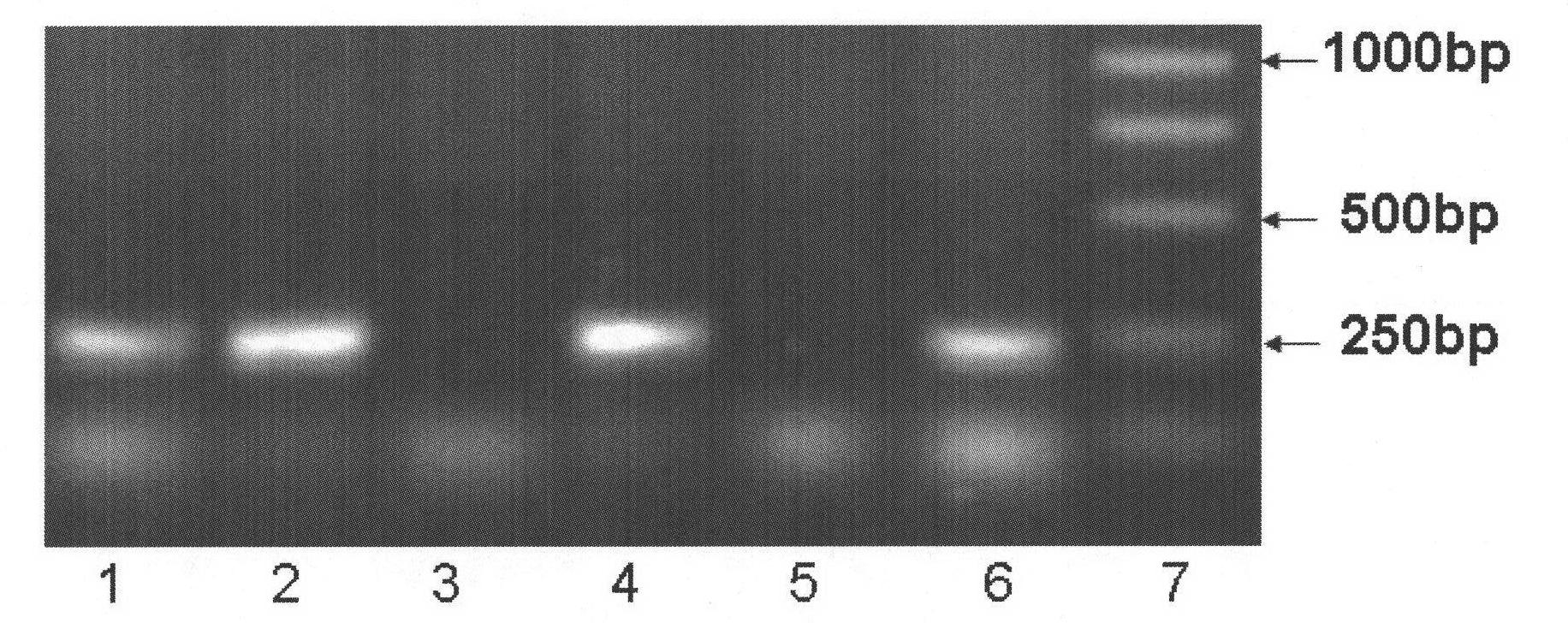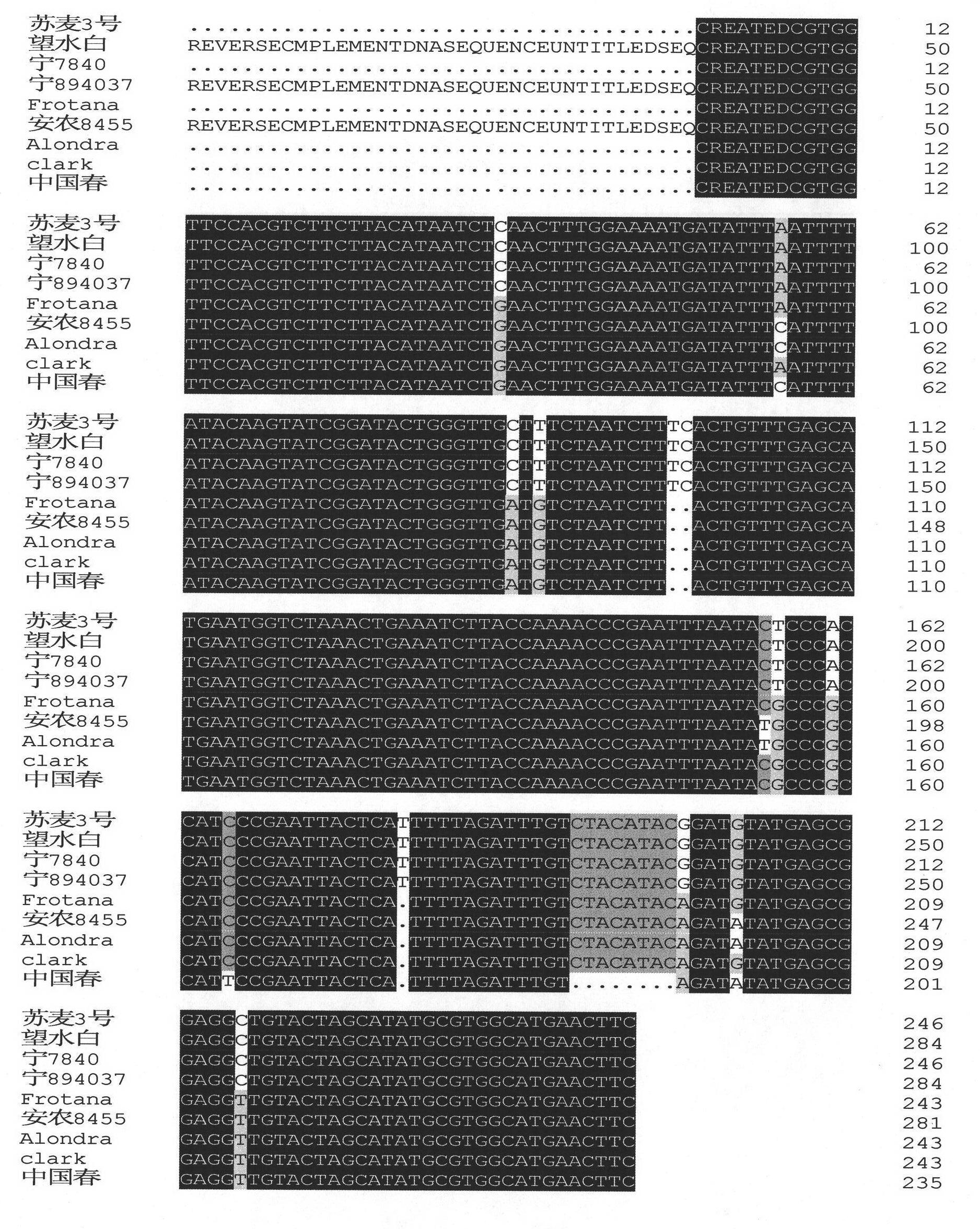SSCP marker closely linked with major wheat scab resistance QTL and application thereof
A technology for wheat scab and scab, applied in the fields of wheat breeding and molecular biology, to achieve the effects of low cost, easy operation and improved breeding efficiency
- Summary
- Abstract
- Description
- Claims
- Application Information
AI Technical Summary
Problems solved by technology
Method used
Image
Examples
Embodiment 1
[0024] Example 1 Chromosomal location of markers
[0025] DNA was extracted from the leaves of wheat varieties Ning 7840 (high resistance to scab), DL 2000Marker (susceptible to scab), Chinese spring, tetrasomy N3BT3A, N3AT3D N3DT3A of Chinese spring, and telosome DT3BL and DT3BS of Chinese spring.
[0026] According to the design and synthesis of PCR amplification primers (LIUSX, Cereal Research Communications, 2008, 36: 195-200.) according to the second gene sequence reported by Liu et al. (2008): Forward primer 5'-CGTGGTTCCACGTCTTCTTA-3' ; The reverse primer 5'-TGAAGTTCATGCCACGCATA-3' (primers were synthesized by Shanghai Sangon Bioengineering Technology Service Co., Ltd., the same below) was used to amplify the DNA of each leaf by PCR. Electrophoresis was carried out on 2.5% agarose gel, and the Chinese Spring, N3AT3D, N3DT3A, and DT3BS with 3BS regions could amplify a band of about 240 bp, while the N3BT3A and DT3BL lacking 3BS could not amplify this band. Determine that...
Embodiment 2
[0028] Example 2 Sequence alignment of PCR amplification products of 9 wheat varieties
[0029] DNA from leaves of 8 wheat varieties Sumai 3, Wangshuibai, Ning 894037, Ning 7840, Annong 8455, Alondra, Clark and Frotana were extracted. The 8 wheat varieties were amplified by PCR with the same primers and separated by agarose gel electrophoresis. Among these cultivars, Sumai 3, Wangshuibai, Ning 894037, and Ning 7840 are four wheat cultivars with main QTLs for scab 3BS resistance; Anong 8455, Alondra and Clark are susceptible cultivars; Frotana is American There is no major QTL for 3BS resistance in varieties resistant to head blight. Amplification result shows, the amplified band of these 8 kinds all can amplify the band of about 240bp in 2.5% agarose gel electrophoresis (such as figure 2 ). ,
[0030] exist figure 2 Middle, 1: Sumai 3; 2: Wangshuibai; 3: Ning 894037; 4: Ning 7840; 5: Frotana; 6: Annong 8455; 7: Alondra; 8: Clark; 9: DL 2000Marker.
[0031] Depend on ...
Embodiment 3
[0033] Embodiment 3, the preparation of denaturing sample solution and non-denaturing polyacrylamide gel
[0034] 1. Preparation of denatured sample solution: deionized formamide with a volume ratio of 98%, EDTA with a pH of 10mmol / L = 8.0, xylene cyanol FF with a mass ratio of 0.025%, and bromophenol blue with a mass ratio of 0.025% .
[0035] Preparation method:
[0036] The first is to prepare 10 times xylene cyanol FF and bromophenol blue mother liquor, weigh 0.125g xylene cyanol FF and 0.125g bromophenol blue and dissolve in 50ml formamide.
[0037] Next is the preparation of the denatured sample solution. The method is to take 5ml of 10 times xylene cyanol FF and bromophenol blue mother solution, 1ml of 0.5M EDTA solution with pH 8.0, and add 44ml of formamide to a total volume of 50ml.
[0038] 2. Preparation of 12% non-denaturing polyacrylamide gel: 100 ml of polyacrylamide gel solution contains 11.6 g of acrylamide and 0.4 g of methylenebisacrylamide.
[0039] Prep...
PUM
 Login to View More
Login to View More Abstract
Description
Claims
Application Information
 Login to View More
Login to View More - R&D
- Intellectual Property
- Life Sciences
- Materials
- Tech Scout
- Unparalleled Data Quality
- Higher Quality Content
- 60% Fewer Hallucinations
Browse by: Latest US Patents, China's latest patents, Technical Efficacy Thesaurus, Application Domain, Technology Topic, Popular Technical Reports.
© 2025 PatSnap. All rights reserved.Legal|Privacy policy|Modern Slavery Act Transparency Statement|Sitemap|About US| Contact US: help@patsnap.com



